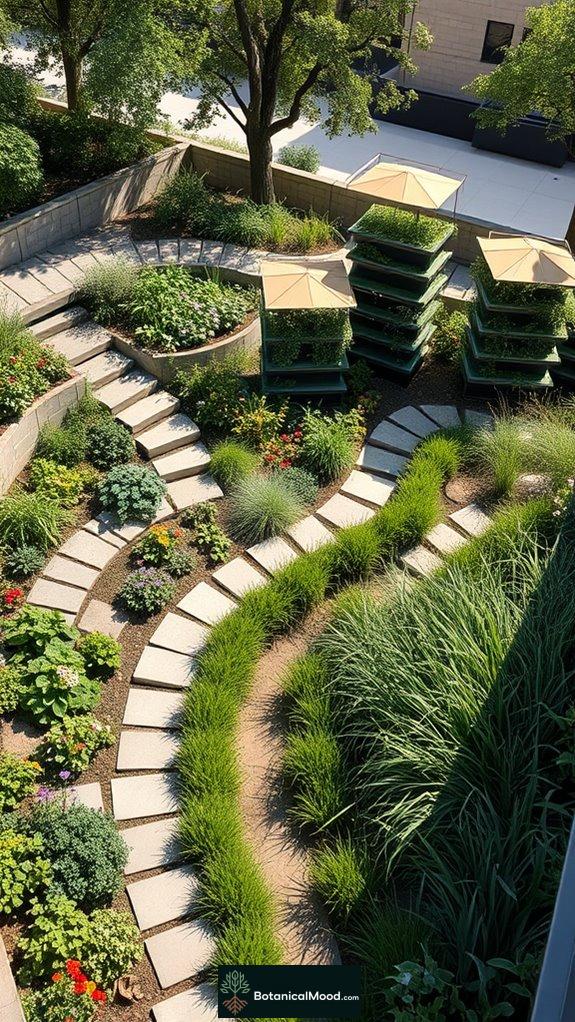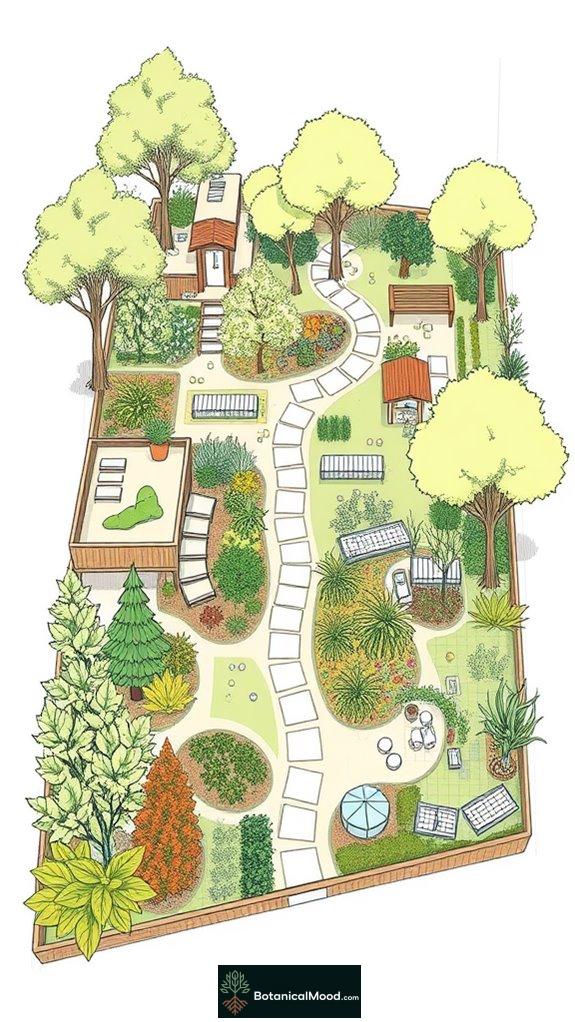Urban gardens embody vibrant green oases, showcasing permaculture design sketches that inspire creativity and sustainability. These illustrations highlight vertical gardening techniques, making the most of limited space while enhancing biodiversity and beauty. Companion planting fosters resilient ecosystems, encouraging healthy growth and reducing pests. Rainwater harvesting systems align with efficient water management, while innovative composting solutions enrich urban soil. With wildlife integration and community engagement, these designs not only transform neighborhoods but also invite exploration into their numerous benefits.
Quick Takeaways
- Design sketches should incorporate vertical gardening techniques to maximize space and enhance aesthetic appeal in urban environments.
- Utilize companion planting strategies to foster biodiversity and create resilient ecosystems within the urban oasis.
- Include water management systems, like rainwater harvesting, to promote sustainable gardening practices and efficient resource use.
- Integrate wildlife-friendly elements, such as bee-friendly flowers and green roofs, to enhance local ecosystems and attract pollinators.
- Emphasize community engagement in design by creating shared garden spaces and hosting workshops that reflect local needs and collaboration.
Vertical Gardening Techniques for Small Spaces

When I think about transforming small spaces into lush, vibrant gardens, vertical gardening techniques immediately come to mind, as they offer incredible opportunities for maximizing limited areas.
By utilizing vertical space efficiency, I can create stunning displays that enhance both beauty and productivity. Trellis gardening is a simple and low-effort technique that supports large plants while saving space. Additionally, vertical gardening can be particularly beneficial in urban environments, where ground space is often limited.
Utilizing vertical space transforms small areas into stunning gardens that blend beauty with productivity.
Plant support systems, like trellises and hanging containers, allow climbing plants to flourish, ensuring ideal sunlight exposure and air circulation.
I've found that integrating structures like green walls and arbors not only saves space but also adds an artistic flair.
This innovative approach inspires my passion for gardening, leading to the creation of Botanical Mood, where I share these ideas with fellow enthusiasts.
Companion Planting for Enhanced Biodiversity

Companion planting is a fascinating technique that not only enhances biodiversity but also creates a more resilient garden ecosystem. By strategically pairing plants, I've discovered the beauty of native partnerships that attract diverse wildlife and improve soil health. For instance, marigolds act as effective pest deterrents for tomatoes, while basil supports pepper plants by keeping aphids at bay. These innovative combinations not only optimize space but also foster a healthier garden ecosystem within the ecosystem. Additionally, incorporating nitrogen-fixing plants can significantly improve soil fertility, benefiting all surrounding plants. As I explore the concept of companion planting, I'm excited to share how these practices contribute to a vibrant, sustainable urban oasis, reflecting my passion for permaculture and botanical design.
Efficient Rainwater Harvesting Systems

Efficient rainwater harvesting systems can transform how we manage water in our gardens and urban spaces.
By integrating innovative storage solutions, we can notably enhance our water conservation efforts.
Consider these key elements:
- Downspout connections maximize collection.
- First flush diverters guarantee clean water.
- Permeable pavements improve infiltration.
- Smart systems adapt to weather changes.
In addition, utilizing swales and rain gardens can further enhance the efficiency of rainwater management in your backyard.
Implementing rainwater filtration and smart storage solutions not only reduces reliance on municipal water but also beautifies our environment. Rainwater harvesting systems effectively address water scarcity in densely populated urban areas, ensuring a sustainable future.
I created Botanical Mood to inspire sustainable practices, proving that efficient water management can lead to thriving, vibrant urban environments.
Composting Solutions for Urban Gardens

Composting solutions for urban gardens offer a practical way to recycle organic waste, enriching soil and supporting sustainable practices.
By utilizing innovative composting techniques like vermicomposting or EMO composting, we can adapt to limited spaces while minimizing odors. The heap method and tumbler composting also deliver effective results, transforming kitchen scraps into nutrient-rich soil.
These composting benefits not only enhance our gardens but also foster community engagement, creating green oases in concrete jungles. Additionally, incorporating edible landscaping into composting practices can further maximize the use of space and resources in urban settings.
At Botanical Mood, I've discovered that integrating these techniques elevates our gardening experience, making urban living both sustainable and beautiful.
Let's embrace these solutions for a thriving urban environment!
Integrating Wildlife Into Urban Landscapes

Creating a vibrant urban garden is about more than just growing plants; it's an opportunity to integrate wildlife into our cities, enriching both our environments and our lives.
By establishing wildlife corridors and enhancing habitat connectivity, we can support urban biodiversity.
Consider these innovative strategies:
- Create tunnels and bridges for safe wildlife passage
- Design pocket parks to foster small species habitats
- Incorporate green roofs to mitigate heat and provide shelter
- Use native plants to attract pollinators
Additionally, planting bee-friendly flowers can significantly increase the number of pollinators visiting your garden, contributing to a healthier ecosystem.
I developed Botanical Mood to inspire others toward these sustainable practices, showcasing how we can harmonize nature with urban living for a richer ecosystem.
Visual Patterns in Garden Design

How can visual patterns transform a garden into an enchanting sanctuary?
By incorporating color harmony and rhythmic patterns, I create a sense of visual unity that captivates the senses.
Geometric layouts, like grids and circles, bring structure, while layered designs add depth through textural contrast.
Focal points, such as vibrant flowers or unique sculptures, draw the eye, enhancing the garden's beauty.
I believe in the power of ecological aesthetics, where nature inspires each element.
These thoughtful patterns not only please the eye but also foster a sustainable environment, reflecting my passion for innovative gardening showcased on my website, Botanical Mood. Furthermore, implementing rainwater harvesting techniques can significantly enhance the garden's sustainability.
Emulating Natural Ecosystems in Urban Settings

Urban environments often seem disconnected from nature, yet I believe there's immense potential to replicate the complex beauty of natural ecosystems within these bustling settings.
By integrating features that support urban wildlife and restore natural habitats, we can foster sustainability.
Consider these innovative ideas:
- Green roofs and walls enhance insulation while providing habitats.
- Native plants create corridors for local wildlife.
- Bioswales and rain gardens manage stormwater naturally.
- Vertical farming maximizes space to grow food sustainably.
Additionally, incorporating regenerative planting practices can further enhance soil health and biodiversity, reinforcing the resilience of urban ecosystems.
These approaches not only beautify our cities but also create thriving ecosystems, which is why I created Botanical Mood—to inspire such transformations.
Community Engagement Through Shared Green Spaces

While many might overlook the importance of green spaces in our neighborhoods, I've found that these areas can greatly enhance community engagement and social connections.
Parks and community gardens serve as neutral grounds for residents to gather, fostering meaningful interactions.
Through community workshops and neighborhood collaborations, we can co-create spaces that reflect our needs and interests.
These shared experiences not only strengthen bonds but also cultivate a sense of belonging. Additionally, incorporating principles of sustainable permaculture design can help ensure that these spaces are not only beautiful but also resilient and productive for the community.
Sustainable Garden Sketch Layouts

Creating a sustainable garden layout isn't just about placing plants in the ground; it's an art form that involves understanding the unique characteristics of your environment.
To achieve beautiful and functional sustainable layouts, consider these key elements:
- Natural Patterns: Embrace your local ecosystem.
- Multilayered Environments: Incorporate trees, shrubs, and groundcovers.
- Locally Sourced Materials: Use recycled items for hardscaping.
- Adaptability: Design for changing environmental conditions.
These principles enhance garden aesthetics, fostering a vibrant ecosystem. Additionally, utilizing creative concepts for sustainable design can lead to a more enriching garden experience.
I created Botanical Mood to share innovative ideas that inspire sustainable gardening practices, helping you visualize your own green paradise.
Urban Homestead Garden Blueprint

Designing your urban homestead garden blueprint requires thoughtful consideration of space and resources, especially when you want to maximize both beauty and functionality.
I focus on raised bed designs to cultivate urban food production efficiently, ensuring they're accessible for maintenance and harvesting.
By integrating elements like greenhouses and paths, I create a seamless flow that enhances productivity. Water catchment systems help sustain diverse microclimates, allowing for various plant types to thrive. Additionally, incorporating companion planting techniques can optimize space and improve plant health.
Through this blueprint, I aim for an engaging, educational garden that inspires others, reflecting my passion for sustainable living.
After all, it's about creating a thriving ecosystem right in our backyards.
Homestead Garden Spatial Arrangement

How can we best arrange our homestead gardens to maximize both productivity and beauty?
By focusing on garden layout and spatial efficiency, we can create stunning yet functional spaces.
Here are some strategies to contemplate:
- Utilize vertical structures like trellises to save space.
- Plant fruit trees and perennial crops for long-term benefits.
- Zone areas for high-use crops near living spaces.
- Incorporate narrow pathways for easy access and movement.
Additionally, consider integrating sustainable vertical gardens into your design to enhance biodiversity and aesthetic appeal.
I created this website, Botanical Mood, to inspire others in their gardening journeys, showcasing how innovative designs can transform any space into a flourishing oasis.
Garden Maintenance Responsibilities

While maintaining a garden might seem intimidating, a well-structured approach to garden responsibilities can greatly enhance both productivity and beauty.
Incorporating seasonal tasks like pruning and mulching not only promotes plant health but also fosters a thriving ecosystem. Regular pest monitoring is crucial; early detection helps mitigate potential harm to plants.
Utilizing essential tools such as wheelbarrows and rakes streamlines maintenance efforts, making routines predictable and efficient. By observing plant behaviors and adapting strategies, gardeners can refine their techniques over time. Additionally, implementing companion planting strategies can significantly boost the overall yields of raised bed gardens, creating a more diverse and productive growing environment.
This process aligns with the vision behind Botanical Mood, inspiring creativity and innovation in sustainable gardening practices.
References
- https://therike.com/blogs/sustainable-living/sustainable-design-for-small-spaces
- https://thedruidsgarden.com/2016/09/25/permaculture-design-by-nature-and-the-magic-of-intentionality/
- https://www.goldhatnursery.com/p/urban-permaculture-green-solutions
- https://www.archdaily.com/1017400/architecture-inspired-by-permaculture-how-to-integrate-its-design-principles-across-diverse-contexts
- http://craftthyme.com/urban-permaculture-plan/
- https://trueorganic.earth/stylish-space-saving-vertical-gardening-at-home/
- https://urbanpermaculture.education/small-green-spaces/
- https://mostardi.com/vertical-gardening-for-small-spaces/
- https://permaculturepractice.com/small-space-permaculture/
- https://dug.org/vertical-growing/

Leave a Reply